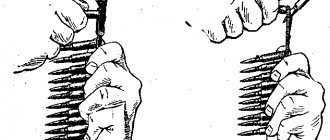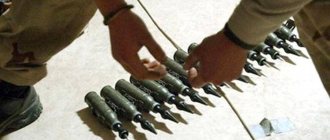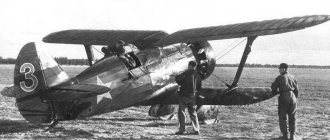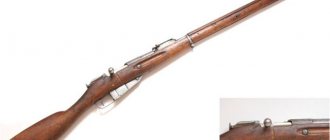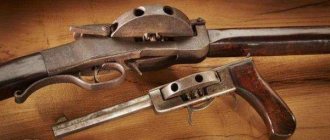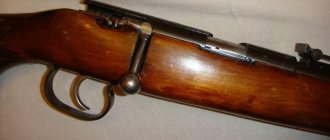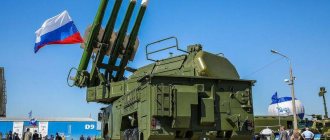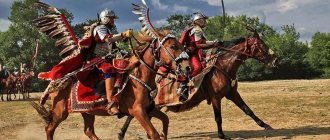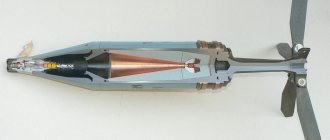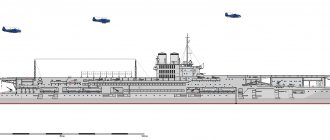2.1. Fragmentation ammunition
The main damaging factor of fragmentation ammunition is the field of high-velocity fragments of the body or ready-made destructive elements.
Designed mainly to destroy manpower. When, for example, an aerial fragmentation bomb explodes, a large number of fragments are formed, which scatter in different directions at a distance of up to 300 meters from the explosion site.
| Rice. 2.1. Various types of fragmentation ammunition |
The improvement of fragmentation ammunition is moving along the path of creating ammunition with ready-made or semi-ready lethal elements. A special feature of such ammunition is a huge number (up to several thousand) of elements (balls, needles, arrows, etc.) weighing from one to several grams. As a rule, ready-made lethal elements are located inside submunitions (each with up to 300 or more destructive elements), which, in turn, are loaded into cassettes. The leading countries of the world are armed with aviation cluster bombs, cluster artillery shells, cluster warheads of ballistic missiles and rockets for rocket artillery systems. Under the influence of an expelling charge, the cassettes are destroyed above the ground, and the flying submunitions explode over an area of up to 250 thousand m2.
Anti-personnel mines can also be equipped with ready-made destructive elements.
| Rice. 2.2. Fragmentation ammunition with ready-made submunitions (GPE) |
Various shelters, trenches, and trenches protect from damaging elements.
Detail of a standard cumulative projectile
The principle of operation of the mortar
The cumulative projectile consists of:
- Fuse and head;
- notches and rings;
- charge and detonator;
- retainer and tracer;
- stabilizer, housing, blade.
The concept of cumulative effect
The effect invented by Bereskov means an instant strengthening of ongoing processes due to the coherence of joint efforts.
A small recess is made in one of the parts of the charge, which is covered with a layer of metal with a total thickness of 1-3 mm. This recess is always turned towards the goal.
The explosion occurring at the edge of the crater causes the blast wave to pass along the side walls, thereby flattening them towards the axis of the projectile. During the explosion, a large pressure is created, which transmutes the crater lining into a quasi-liquid, then moves it along the axis of the ammunition. These actions form a jet that reaches speeds of up to (10 km/s).
IMPORTANT! The lining does not melt, but is deformed into a liquid under the influence of high pressure on it. If the cumulative jet hits the target, then the strength of the armor does not matter
All that matters is the density and thickness of the metal
The penetration ability of a metal jet depends on:
All that matters is the density and thickness of the metal. The penetration ability of a metal jet depends on:
If the cumulative jet hits the target, then the strength of the armor does not matter. All that matters is the density and thickness of the metal. The penetration ability of a metal jet depends on:
- length;
- cladding density;
- target armor material.
IMPORTANT! The most effective action (focal) occurs when a projectile explodes at a short distance from an armored target. The armor and the shaped charge interact with each other, i.e. the pressure created from the explosion of the projectile’s components is so high that the strongest armor will behave like a liquid. Standard ammunition penetrates armor thickness from 5 to 8 of its calibers
Standard ammunition penetrates armor thickness from 5 to 8 of its calibers
The armor and the shaped charge interact with each other, i.e. the pressure created from the explosion of the projectile’s components is so high that the strongest armor will behave like a liquid. Standard ammunition penetrates armor with a thickness of 5 to 8 calibers.
Note! If the crater lining is made of depleted uranium, the armor-piercing power of the projectile increases to 10 calibers. Advantages and disadvantages. Advantages and disadvantages
Advantages and disadvantages
HEAT ammunition has positive and negative sides. The absolute advantages of such shells:
- Penetrating almost any layer of armor;
- The jet penetrates armor regardless of the initial speed of the projectile;
- Powerful action after hitting the target.
But cumulative ammunition also has its disadvantages:
- Difficulties in mass production due to the complexity of the design;
- Great difficulties in using MLRS ammunition;
- Vulnerabilities in penetrating reactive armor.
A warhead with a cumulative effect, used in the production of ammunition for RPGs, anti-tank guns and mines. When a projectile filled with “liquid metal” hits a target, it will most likely cause an explosion of ammunition. In this case, the crew will die.
Interesting fact! Modern ATGMs are capable of penetrating armor plates 10 cm thick.
Interesting Facts
- Initially, cumulative shells were called armor-piercing shells, since it was believed (based on the shape of the pierced crater) that they actually burned through armor. In reality, when the charge is detonated, the temperature of the lining reaches only 200–600 °C, which is significantly lower than its melting point.
- It is widely believed that when a cumulative jet hits a tank or other armored target, those inside die from barotrauma due to a sharp increase in pressure in a closed volume after breaking through the armor, and this is one of the reasons why infantry fighting vehicles prefer to ride outside, on the top sheet, rather than inside cars, and this is also why some tankers prefer to drive with open hatches to relieve pressure. In reality, the opposite is true: the expanding gases of a detonated shaped charge cannot penetrate the pierced armor into the small hole formed, but open hatches lead to the shock wave “flowing in” and defeating the crew.
The blank cracked the tank
Purpose of a current transformer and its operating principle
The improvement of armor protection, as well as the use of its inclined arrangement, reduced the effectiveness of a solid armor-piercing projectile. When it hit an oblique plane, it most often ricocheted, although due to its characteristics it was sometimes capable of so-called normalization. It consisted in the fact that after the first contact with the tip, the motion vector changed slightly (up to five degrees), and the angle of impact on the armor became more obtuse. This led to a more effective distribution of the load on the area of the affected protection, and even if the armor did not penetrate through, a kind of funnel was formed on its inner side, and pieces of metal flew inside the vehicle at high speed, maiming and killing the crew. In addition, one should not discount the compression effect, in other words, a strong and rapid change in pressure (in essence, a powerful blow of an air wave).
Tank evolution
The first tanks were slow, mobile artillery batteries (sometimes with multiple guns) protected by bulletproof armor. These were analogues of armored trains, with the difference that they could move not on rails, but on rough terrain and, of course, on roads. The evolution of technical solutions has led to new ways of using armored vehicles; they have become more mobile and taken over some of the functions of cavalry. The most advanced achievements could be boasted by the Soviet engineering school, which by the end of the thirties of the 20th century had come to a general concept that determined the appearance of a modern tank. All other countries until the end of the war continued to build combat vehicles according to an outdated design, with a front transmission, narrow tracks, riveted hulls and carburetor engines. Nazi Germany achieved several greater successes compared to Great Britain and the United States. The engineers who built the Tigers and Panthers made a number of attempts to increase the durability of their vehicles by using inclined armor. The Germans also had to change the width of the tracks according to the conditions of the Eastern Front. Long-barreled guns became another feature that brought the characteristics of Wehrmacht tanks closer to modern standards. At this point, progress in the camp of our enemies stopped.
Solutions
Gatling machine gun: operating principle, characteristics
Below are some possible solutions to the previously mentioned problems associated with cumulative effects:
Move beyond project-specific environmental assessments: cumulative effects are best understood and managed at the policy, program or sector level due to the need for long-term planning. Developing national environmental databases: Agencies and organizations conducting research in countries share their data in a standardized approach that allows information to be pooled and used across different studies. Many practitioners use computer modeling to predict the potential impacts of activities and changes in land use; therefore, an inventory of national environmental baseline data will improve the predictive ability of these models. Coordination among jurisdictional agencies: Fragmentation of environmental assessments across jurisdictions does not adequately address issues of cumulative impacts. Coordination between agencies at different levels (national, regional, local) can help set environmental goals, anticipate and plan for future development, and share best practices. Regional environmental assessment (REA): The cumulative impacts of human activities on the environment are better understood at a regional scale. Because REAs examine the effects of events occurring in a region, they are more effective than conventional environmental assessments in analyzing cumulative effects
They can also help make more strategic decisions for future development by helping to better understand the state of the environment on a regional scale. Consider cumulative effects early: It is important that cumulative effects are considered early and throughout the environmental assessment and life of the project. In particular, for projects with unknown or uncertain impacts, new information must be continually collected and management and mitigation approaches must be modified as these uncertainties become clearer.
Operating principle
High explosive (photo of charge structure) A high explosive projectile, the principle of operation of which was described above, has a wide range of applications. But in combat conditions they are most often used to destroy fortified structures and enemy personnel. High-explosive shells are used by artillery units of different calibers, mainly 120 and 152 mm.
After hitting targets, a powerful high-explosive effect of ammunition occurs, accompanied by a blast wave. In other words, gaseous products are released due to the explosive, which, after detonation, form a high-temperature zone, a blast wave and a large radius of dispersion of projectile fragments.
The principle of operation of a high-explosive projectile is the power of the explosion, capable of completely destroying the target with one hit
Explosion of a high-explosive shell
The strength and power of the explosion depends on the released gaseous products. This makes it quite difficult to determine the exact parameters. Therefore, all available data on the parameters of explosive force and the radius of destruction of high-explosive projectiles are completely conditional.
The main advantage of this projectile is the ability to increase parameters by increasing explosives and not being affected by the caliber of the weapon used.
105 mm armor-piercing high-explosive projectile
For example, armor-piercing high-explosive projectiles have small calibers, but due to the high explosive content, armor penetration and thin walls of the projectile, having the property of plasticity, they penetrate deep under the armor and after detonation they cause great destruction and impact directly on the internal part of armored vehicles, which leads to completely disabling it. If the armor has not been penetrated, chips form on the inside.
High explosive fuses
The first fuse for high-explosive fragmentation ammunition was an ordinary fuse, which was ignited when fired from a cannon and initiated the detonation of explosives after a certain time. However, after the advent of rifled guns and conical-shaped projectiles, which guaranteed that the front part of the hull would encounter an obstacle, impact fuses appeared. Their advantage was that the explosive exploded immediately after contact with the obstacle. For destruction, the impact fuses were equipped with a moderator. This allowed the ammunition to first penetrate the obstacle, thereby dramatically increasing its effectiveness. By equipping a landmine with such a fuse with a more massive body with thick walls (which made it possible, due to kinetic energy, to penetrate deep into the walls of long-term firing points), we obtained a concrete-piercing projectile.
By the way, at the initial stage of the Great Patriotic War, they successfully fought German armored vehicles with the help of 152-mm concrete-piercing shells. When a shell hit a medium or light German tank, due to its weight, it first destroyed the vehicle, tore off the turret, and then exploded. The disadvantage of impact fuses was that when they hit viscous soil (for example, a swamp), they did not work. This problem was eliminated by a remote fuse, which allows the ammunition to be detonated at a certain distance from the muzzle of the gun barrel. Currently, this type of detonator is used in almost all OFS. It allows, for example, firing tank guns at air targets (helicopters).
About cumulative
Such ammunition was first used by Nazi Germany in 1941. At that time, the USSR did not expect the use of such projectiles, since their principle of operation was known, but they were not yet in service. The key feature of such projectiles was that they had high armor penetration due to the presence of instantaneous fuses and a cumulative notch. The problem encountered for the first time was that the projectile rotated during its flight. This led to the dispersion of the cumulative arrow and, as a result, reduced armor penetration. To eliminate the negative effect, it was proposed to use smooth-bore guns.
Read also: Vertebrology services at Hartman Clinic
Cumulative ammunition and grenades
HEAT weapons, being very effective, have found their application as grenades used on hand and rifle grenade launchers. This type of projectile can be easily used by infantry for medium armored vehicles in any conditions.
The Nazis were the first to use cumulative ammunition in the form of a grenade in the Second World War, where they showed excellent results and significantly complicated the use of lightly armored vehicles in various conditions.
Cumulative projectile - photo of broken armor
The first cumulative grenades had a mass of up to 3 kg, a diameter of 15 cm and a weight of contained explosives of up to 1 kg. Next, scientists around the world developed universal cumulative grenades, which eventually received calibers of 30, 40, 80 and 90 mm. Penetration averaged 300 mm. This type of shell was used on RPGs and Bazookas.
HEAT grenade used by bazooka
Performance characteristics:
| Length in mm | 540 |
| Diameter in mm | 60 |
| Weight in kg | 1,6 |
| Mass of explosive in g | 220 |
| Mass of reactive charge in g | 75 |
| Initial speed in m/s | 85 |
| Maximum penetration in mm | 300 (at a distance of up to 350 meters) |
The principle of operation of a shaped charge made it possible to use grenades against lightly armored vehicles. They showed high efficiency in completely disabling equipment and crew.
German cumulative air-to-ground missile
Tactical and technical characteristics of the air-to-ground missile:
| Length in mm | 812 |
| Diameter in mm | 55 |
| Weight in kg | 3,8 |
| Launch range in km | 1,5 |
| Effective range in km | up to 1.0 |
| Thrust of the installed solid propellant rocket motor in kgf | 245 |
| Engine operating time in sec | 75 |
| Weight of warhead in kg | 0,5 |
| Detonator type | Duplex (time delayed contact fuze) |
| Maximum penetration in mm | 200 |
During World War II, German scientists created an unguided cumulative air-to-ground missile. The purpose of such missiles was to destroy enemy armored vehicles from the air.
The cumulative missiles had a high initial speed of 570 meters per second, a caliber of 130 mm and a penetration capacity of up to 200 mm. During the research work, three such missiles were created, after which the project was canceled for unknown reasons.
Passive protection
Of course, immediately after shaped charges appeared in armies, means began to be developed to prevent them from hitting tanks and other heavy military equipment. For protection, special remote screens were developed, installed at some distance from the armor. Such products are made of steel gratings and metal mesh. The effect of a cumulative jet on a tank's armor, if present, is nullified.
Since when a projectile hits a screen it explodes at a considerable distance from the armor, the jet has time to collapse before it reaches it. In addition, some types of such screens are capable of destroying the contacts of the detonator of cumulative ammunition, as a result of which the latter simply does not explode at all.
The mechanism of action of a shaped charge[edit | edit code]
Cumulative jet edit | edit code
After the explosion of the detonator capsule of the charge, a detonation wave arises, which moves along the axis of the charge.
The wave, propagating towards the facing of the cone surface, collapses it in the radial direction, and as a result of the collision of parts of the facing, the pressure in it increases sharply. The pressure of the explosion products, reaching about 1010 Pa (105 kgf/cm²), significantly exceeds the yield strength of the metal, therefore the movement of the metal lining under the influence of the explosion products is similar to the flow of a liquid, which, however, is caused not by melting, but by plastic deformation.
Similar to a liquid, the lining metal forms two zones: a large mass (about 70–90%) slowly moving “pestle” and a smaller mass (about 10–30%) thin (about the thickness of the lining) hypersonic metal jet moving along the axis of symmetry of the charge , the speed of which depends on the detonation speed of the explosive and the geometry of the funnel. When using funnels with small angles at the apex, it is possible to achieve extremely high speeds, but at the same time the requirements for the quality of the lining are increased, since the likelihood of premature destruction of the jet increases. Modern ammunition uses funnels with complex geometry (exponential, stepped, etc.) with angles ranging from 30 to 60°; the speed of the cumulative jet reaches 10 km/s.
| The process of pressing in a copper cladding skirt, it is also in the form of a finished product and inside the loaded ammunition in a section |
Since when a cumulative jet meets the armor, a very high pressure develops, one or two orders of magnitude greater than the tensile strength of metals, the jet interacts with the armor in accordance with the laws of hydrodynamics, that is, upon collision they behave like ideal liquids. The strength of armor in its traditional sense in this case plays practically no role, and the density and thickness of the armor come first.
The theoretical penetration ability of cumulative projectiles is proportional to the length of the cumulative jet and the square root of the ratio of the density of the cone (funnel) lining to the density of the armor. The practical depth of penetration of a cumulative jet into monolithic armor for existing ammunition varies in the range from 1.5 to 4 calibers.
When the conical shell collapses, the velocities of individual parts of the jet turn out to be different, and the jet stretches in flight. Therefore, a slight increase in the gap between the charge and the target increases the penetration depth due to the lengthening of the jet. However, at significant distances between the charge and the target, the continuity of the jet is disrupted, which reduces the armor-piercing effect. The greatest effect is achieved at the so-called “focal length”, at which the jet is stretched as much as possible, but has not yet been broken into separate fragments. To maintain this distance, various types of tips of appropriate lengths are used.
When moving in a solid medium, a gradiently broken cumulative jet self-centers, and the diameter of the track decreases as it moves away from the focal point. When a cumulative jet broken into fragments moves in liquids and gases, each fragment moves along its own trajectory, and the diameter of the track increases as it moves away from the focal point. This explains the sharp decrease in the penetration ability of high-gradient cumulative jets when using anti-cumulative screens.
The use of a charge with a cumulative notch without metal lining reduces the cumulative effect, since instead of a metal jet there is a jet of gaseous explosion products; however, this achieves a significantly stronger armor effect.
Impact coreedit | edit code
Main article: Shock core
Impact core
- a compact metal form, reminiscent of a pestle, formed as a result of compression of the metal lining of a shaped charge by the products of its detonation.
To form an impact core, the cumulative notch has an obtuse angle at the apex or the shape of a spherical segment of variable thickness (thicker at the edges than in the center). Under the influence of a shock wave, the cone does not collapse, but is turned “inside out.” The resulting projectile with a diameter of a quarter and a length of one caliber (the original diameter of the notch) accelerates to a speed of 2.5 km/s. The armor-piercing effect of the core is lower than that of a cumulative jet, but it remains at a distance of up to 1000 calibers. In contrast to the cumulative jet, which consists of only 15% of the lining mass, the impact core is formed from 100% of its mass.
Meaning of "Cumulative" in dictionaries
Cumulative
– A philosophical dictionary is gradually concentrated, cumulatively accumulated over time, containing its entire historical past.
Similar words in dictionaries
Cumulative Vote – Economic Dictionary
— voting procedure in multi-member electoral districts, in which a voter has the right to combine part or all of his votes and cast them for one of the candidates.
Cumulative Vote – Legal Dictionary
Cumulative Annual Income (Reduced to Present Value) – Economic Dictionary
Investment income discounted back from the cumulative figure (i.e., reduced to a present-day valuation using an assumed discount rate). The cumulative figure represents the amount of money (income over several target years) that is achieved by compounding annual interest on the amount of income received in previous years. A synonym for the term is internal rate of return.
Cumulative Dividend – Economic Dictionary
dividend accrued and paid on cumulative preferred shares. If the annual meeting of shareholders, which was supposed to make a decision on the payment of dividends accumulated on cumulative shares, decided not to pay them or pay them incompletely, shareholders holding cumulative preferred shares acquire the right to vote on all issues within the competence of the meeting of shareholders. This right comes into force immediately after this meeting and terminates upon full payment of dividends.
Cumulative Income Above the Norm – Economic Dictionary
The sum of the differences between a stock's expected return and its actual return, which depends on various news announcements in the market.
Cumulative Fertility Rate, Cfr – Sociological Dictionary
- the total number of live births by a certain age, per 1000 women in a real or hypothetical cohort. For a cohort, this coefficient is equal to the number of children ever born. For the period - it is calculated by summing the age-specific fertility rates from age 15 years to age x years.
Cumulative Share – Economic Dictionary
(accumulating unit) a share in an investment fund, dividends on which, after payment of income tax, remain at the disposal of the fund, increasing the share of its owner.
Cumulative Transfer Adjustment Account (CTAC) – Economic Dictionary
An item in the transfer balance that reflects the accumulated profits and/or losses from transfer transactions over several years. Having a CPC account is required by FASB Rule No. 52.
Cumulative Recorder – Psychological Dictionary
A device often used in operant conditioning research that automatically graphs responses over time. Paper is fed into this device at a certain interval while the pen moves across the paper each time a response is received. The response rate can thus be determined from the slope of the curve; the steeper the slope, the higher the coefficient. A flat curve indicates no response.
Cumulative Recorder – Psychological Encyclopedia
Cumulative Effect – Economic Dictionary
economic, financial effect achieved through the gradual accumulation, concentration of factors and their subsequent “explosive” action.
Cumulative Effect – Economic Dictionary
- an effect achieved through the gradual accumulation, concentration of factors and their subsequent explosive action.
Cumulative Effect – Legal Dictionary
HEAT projectile
– an artillery shell of primary purpose, in which a charge of cumulative action is used to hit a target (see Cumulative effect). The cumulative projectile is designed for firing at armored targets (tanks, infantry fighting vehicles, armored personnel carriers, etc.), as well as at reinforced concrete fortifications. structures. In the USSR, the first experiments with cumulative projectiles were carried out in 1934 by S.N. Dyadichev. Experimental cumulative shells were used in 1938 during the civil war. wars in Spain. In World War II, cumulative shells were widely used by all belligerent armies. First Fatherland. sample of a cumulative projectile adopted by the Sov. Army in Jan. 1942, was developed under the leadership of K.K. Snitko. During the Great Patriotic War, the war of K. s. sometimes called "armour-burning" or "termite". A cumulative projectile (see figure) consists of a body, a bursting charge, a cumulative notch, a fuse and a tracer. High explosives with a high detonation speed (RDX, etc., as well as their mixtures and alloys with TNT in various proportions) are used as a bursting charge. The armor penetration of a cumulative projectile depends on the shape, size and material of the lining of the cumulative recess, the mass and properties of the explosive charge, the response time of the detonation chain (fuse design), the rotation speed of the projectile, the angle of its meeting with the obstacle, and the characteristics of the armor. Rotation of a cumulative projectile leads to the dispersion of the cumulative jet under the influence of centrifugal force and a decrease in its armor penetration. Therefore, in some cumulative projectiles of rifled guns, in order to prevent rotation, the cumulative unit or driving belt is rotated relative to the projectile body. Another way to increase the armor penetration of a cumulative projectile is to use smooth-bore guns. To stabilize in flight, non-rotating cumulative projectiles have a caliber or over-caliber tail; the latter opens after the projectile exits the barrel. Such devices help improve the efficiency of the cumulative projectile, but complicate the design. The armor penetration of rotating cumulative projectiles is usually about two calibers, non-rotating - about four or more. K ser. 70s K. s. widely used for shooting from art. various tools types (including tank and recoilless). Lit.: Latukhin A.N. Anti-tank weapons. M, 1974, Artillery and missiles. M., 1968.
Difficult situation on the Eastern Front
It should also be noted that at the beginning of the war it was extremely difficult for the Germans to fight Soviet armored vehicles. All medium, and especially heavy tanks in service with the Red Army had reliable shell-proof armor, which was also inclined. The caliber of the turret guns, if there were any (and the T-1, for example, was armed only with a machine gun), was not enough to hit the T-34 or KV. Only attack aircraft, field or anti-aircraft artillery, which usually fired blanks, could fight our tanks. The effectiveness of the application increased if the charge was cumulative. The sub-caliber projectile also had strong armor-piercing power, but it turned out to be too complex to produce and required high costs, and Germany, which fought in addition to the Eastern Front both at sea and in Africa, had to economize.
History of creation
| date | Event |
| 1864 | The discovery of the cumulative effect, which made it possible to develop the principle of a cumulative projectile for the production of ammunition |
| 1910 – 1926 | Study of the cumulative effect, creation of cumulative projectiles and their testing |
| 1935 | The creation of the first successful cumulative projectiles by the German scientist Franz Rudolf |
| 1940 | The beginning of the work of American scientists on the creation of cumulative shells and grenades. Use of cumulative shells by the German army |
| 1942 | Creation and adoption of cumulative projectiles into service by the USSR. The period when cumulative shells appeared in artillery |
| 1950 | The creation by US scientists of the first projectile with high stabilization and the beginning of work on improving cumulative weapons |
| 1960 | Development and testing of a balanced cumulative projectile by Soviet scientists |
| 1990 | Soviet scientists created the first tandem cumulative ammunition with armor penetration up to 800 mm |
In 1864, military engineer M. Bereskov (he was the first to come up with a cumulative projectile) discovered the cumulative effect, after which he began testing and applying developments in the destruction of solid objects. The military was amazed at the effect of a cumulative projectile on armored vehicles. It was from this moment that Western scientists began researching this effect.
From 1910 to 1926, research work and the creation of various types of cumulative shells and mines continued. The purpose of these experiments was to find the correct shape and material, which, when used together, could pierce objects that had a large armor thickness.
In 1935, a young German scientist began work on creating cumulative artillery shells, which were actively used in the initial stage of World War II. Seeing the potential of cumulative projectiles, Soviet scientists, using the example of German ammunition, began to develop and produce their own weapons. In 1942, Soviet cumulative shells began to be used on 76 and 122 mm caliber artillery weapons.
The design of a cumulative projectile of the Second World War
In mid-1950, US scientists patented a new type of cumulative projectile, which was highly stabilized during flight and had a unique metal lining. In the same year, a new type of projectile was adopted by the United States.
In 1960, they created a unique cumulative projectile with a new structure and materials that were many times superior to the cumulative projectiles of World War II. From that moment on, hard work began to improve existing developments.
In 1990, a cumulative tandem projectile with a caliber of 130 mm and a penetration of 800 mm was created.
Diagram of the device of a cumulative projectile
A cumulative projectile consists of parts:
- fuse;
- head;
- cumulative funnel;
- ring;
- bursting charge;
- detonator capsule;
- retainer;
- tracer;
- stabilizer;
- frame;
- blade.
Where is it used?
Actually, the cumulative effect itself was probably observed by all people without exception. It occurs, for example, when a drop falls into water. In this case, a funnel and a thin stream directed upward are formed on the surface of the latter.
The cumulative effect can be used, for example, for research purposes. By creating it artificially, scientists are looking for ways to achieve high speeds of substances - up to 90 km/s. This effect is also used in industry - mainly in mining. But it, of course, found its greatest application in military affairs. Ammunition operating on this principle has been used by various countries since the beginning of the last century.
Cost over time
Time calculations are a little different from others. You can't just add up all the times and convert them to . Just like you can’t buy extra time, so each construction/upgrade must be calculated separately and then summed up. All this leads to the fact that the price will be slightly higher than when you simply calculate the cost on calculators.
Upgrade time has been separated from construction time, as only 1 laboratory is available to the player. This means that you cannot speed up the overall progress of upgrades with the help of builders, as you can with buildings. The time for upgrading Heroes was also divided according to other tables, as it takes a colossal amount of time and money.
Time spent on modernization (laboratory)
| 3 | 4 | 5 | 6 | 7 | 8 | 9 | 10 | Cumulative amount | |
| Barbarian | 6h | 1d | 3D | 5d | 10d | 19d 6h | |||
| Archer | 12d | 2d | 3D | 5d | 14d | 24d 12h | |||
| Goblin | 12d | 2d | 3D | 5d | 10d | 20d 12h | |||
| Giant | 1d | 2d | 3D | 5d | 10d | 21d | |||
| Wall Breaker | 1d | 2d | 3D | 5d | 10d | 21d | |||
| Balloon | 1d | 2d | 3D | 5d | 10d | 21d | |||
| Witch | 1d | 2d | 3D | 5d | 7d | 18d | |||
| Healer | 3D | 5d | 7d | 15d | |||||
| The Dragon | 7d | 10d | 12d | 29d | |||||
| P.E.K.K.A | 29d | 28d | 50d | ||||||
| Minion | 5d | 13d | 10d | 14d | 42d | ||||
| Boar Rider | 8d | 22d | 14d | 44d | |||||
| Valkyrie | 10d | 26d | 36d | ||||||
| Golem | 10d | 26d | 14d | 50d | |||||
| Witch | 10d | 10d | |||||||
| Lightning Spell | 6d | 4d | 14d | 24d | |||||
| Healing Spell | 3D | 3D | 5d | 7d | 18d | ||||
| Rage Spell | 10d | 7d | 17d | ||||||
| Jump Spell | 5d | 7d | 12d | ||||||
| Freeze Spell | 36d | 36d | |||||||
| Total | 1d 6h | 3D | 12d | 11d | 57d | 143d | 149d | 152d | 528d 6h |
| Total Crystals | 340 | 780 | 2,435 | 2,175 | 9,072 | 20,365 | 20,287 | 20,657 | 76,111 |
| Monetary equivalent | $4.99 | $9.98 | $19.99 | $19.97 | $74.97 | $149.98 | $149.98 | $154.97 | $549.94 |
The buildings
| 1 | 2 | 3 | 4 | 5 | 6 | 7 | 8 | 9 | 10 | Total | Cumulative amount | |
| Town Hall | 5m | 3h | 1d | 2d | 4d | 6d | 8d | 10d | 14d | 45d 3h 5m | 4d 12h 18m 30s | |
| Clan Fortress | 6h | 1d | 2d | 7d | 14d | 24d 6h | 2d 10h 12m | |||||
| A gun | 32m | 1h 30m | 4h | 12h | 1d 21h 1m | 3D | 13d 18h 2m | 35d | 25d | 51d 21h 1m | 21d 21h 1m | 13d 3h 36s |
| Archer Tower | 45m | 45m | 9h 30m | 4d 17h 30m | 6d | 15d 17h 30m | 51d 17h 30m | 51d 17h 30m | 70d 17h 30m | 28d 17h 30m | 20d 2h 39m | |
| Mortar | 8h | 12h | 1d | 5d 20h | 15d 20h | 15d | 21d | 30d | 29d 20h | 8d 22h 48m | ||
| Air Defense | 1d 5h | 3D | 5d | 21d 5h | 39d 5h | 63d 5h | 48d | 45d 5h | 18d 2h | |||
| Sorcerer's Tower | 1d 12h | 5d 12h | 6d | 33d 12h | 43d 12h | 40d | 32d 12h | 13d | ||||
| Secret Tesla | 18d | 78d | 80d | 56d | 58d | 23d 4h 48m | ||||||
| Crossbow | 62d | 73d | 45d | 13d 12h | ||||||||
| Hell Tower | 62d | 31d | 6d 4h 48m | |||||||||
| Bomb | 30m | 8h 30m | 2d 4h 30m | 6d | 12d | 3d 10h 15m | 2d 1h 21m | |||||
| Giant Bomb | 6h | 6h | 3d 6h | 1d 6h | 16d 6h | 4d 6h | 2d 3h | |||||
| Aerial Bomb | 8h | 1d | 1d 8h | 4d | 1d 16h | 1d 16h | 20h | |||||
| Air Search Mines | 4d | 16d | 4d | 2d | ||||||||
| Elixir Collector | 6m | 2h 36m | 1d 1h 21m | 6d 9h 21m | 26d 21h 21m | 6d 21h 21m | 24d | 10d 21h 21m | 10d 21h 21m | 7d 14h 56m 42s | ||
| Gold Mine | 6m | 2h 36m | 1d 1h 21m | 6d 9h 21m | 26d 21h 21m | 6d 21h 21m | 24d | 10d 21h 21m | 10d 21h 21m | 7d 14h 56m 42s | ||
| Well of the Dark Elixir | 6d | 42d | 24d | 24d | 7d 4h 48m | |||||||
| Gold storage | 1m | 1h 30m | 19h 31m | 1d 4h | 1d | 2d | 4d | 4d 12h 31m | 4d 12h 31m | 4d 12h 31m | 1d 19h 24m 24s | |
| Elixir storage | 1m | 1h 30m | 19h 31m | 1d 4h | 1d | 2d | 4d | 4d 12h 31m | 4d 12h 31m | 4d 12h 31m | 1d 19h 24m 24s | |
| Dark Elixir Storage | 3D | 7d | 11d | 21d | 2d 2h 24m | |||||||
| Military Camp | 5m | 1h | 7h 5m | 16h | 3d 12h 5m | 9d | 4d 12hh 5m | 20d | 40d | 19d 12h 5m | 7d 19h 14m | |
| Barracks | 2h 16m | 10h 16m | 20h | 2d 16h 16m | 3D | 6d | 20d 8h 16m | 24d | 14d 8h 16m | 5d 17h 42m 24s | ||
| Dark Barracks | 8d | 34d | 16d | 29d | 5d 19h 12m | |||||||
| Laboratory | 30m | 5h | 12h | 1d | 2d | 4d | 5d | 6d | 18d 17h 30m | 1d 20h 57m | ||
| Spell Factory | 1d | 2d | 4d | 5d | 6d | 18d | 1d 19h 12m | |||||
| Total | 3h 12m | 1d 43m | 6d 10h 34m | 23d 12h 28m | 80d 13h 48m | 68d 8h 42m | 199d 19h 23m | 353d 1h 32m | 490d 17h 32m | 589d 7h 13m | 1.812d 23h 7m | |
| Total Crystals | 60 | 409 | 1,990 | 6,233 | 16,393 | 13,479 | 34,531 | 55,325 | 74,011 | 85,816 | 288,247 | |
| Monetary equivalent | $4.99 | $4.99 | $19.97 | $49.99 | $119.97 | $99.99 | $254.96 | $399.96 | $534.92 | $619.91 | $2,069.76 |
Heroes
| 7 | 8 | 9 | 10 | Cumulative amount | |
| Barbarian King | 5d | 17d 12h | 135d | 70d | 227d 12h |
| Archer Queen | 157d 12h | 70d | 227d 12h | ||
| Total | 5d | 17d 12h | 292d 12h | 140d | 455d |
| Total Crystals | 1,098 | 2,840 | 42,702 | 20,000 | 20,000 |
| Monetary equivalent | $9.99 | $24.98 | $24.98 | $149.98 | $484.92 |
